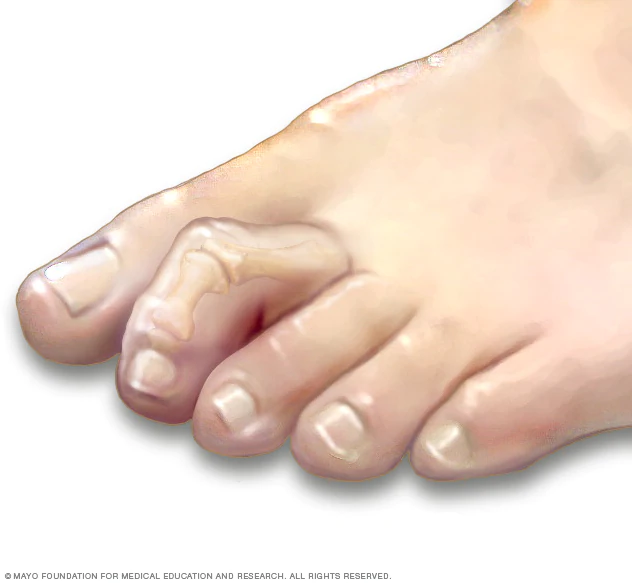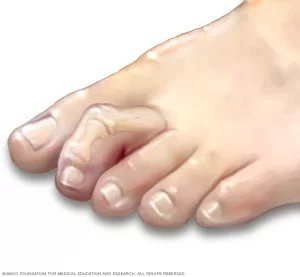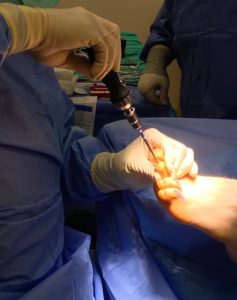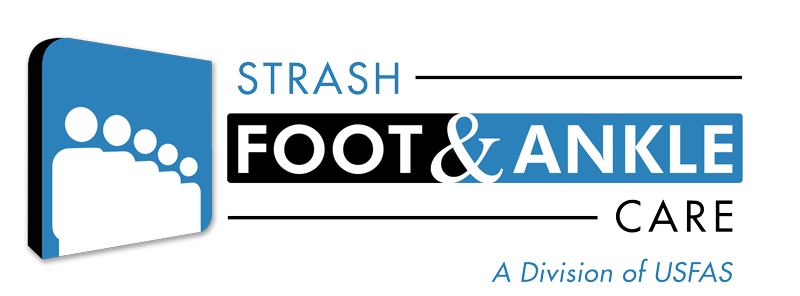
24 Mar How to Know if You Have a Hammertoe
A hammertoe is a deformity that causes the toe to bend or contract downward instead of pointing straight. This deformity can affect any of the lesser toes of the foot – toes 2 through 5. We see hammertoes most commonly of the second or third toe. It’s possible for hammertoes to be present at birth (you can inherit them), but they usually develop over time due to arthritis and/or wearing poorly fitting shoes. Fortunately, hammertoes are a treatable condition.
Our toes have two joints and three bones. A hammertoe occurs when the middle joint becomes flexed or becomes bent in a downward position.
Some of the causes of hammertoes include: a traumatic toe injury, arthritis, high arched feet, weakness of the intrinsic muscles of the feet, wearing shoes that don’t fit properly (short/small shoes), tightened ligaments and tendons of the foot, pressure from a bunion pushing on the second toe, and spinal cord or peripheral nerve damage can cause the toes to become contracted.
There are certain “risk factors” that can increase a person’s likelihood of developing hammertoes. These include a family history of hammertoes (genetics), wearing tight shoes, shoes that are too small, and pointed shoes. Wearing shoes that are too small does not allow the tendons and ligaments in toes to stretch out and this chronic contracture will cause the toes to become permanently “hammered” over time.
How do you know if you have hammertoes? Hammertoes will cause pain and discomfort when you try to walk, with or without shoes. Pain will also occur when you try and move and straighten out your toes. Hammertoe symptoms can be mild or severe. What do hammertoes look like? The toes will bend downwards, there may be the inability to flex or wiggle your toes, the toes will be “claw-like,” a corn (thickened skin) may be on top of the toe and there will be pain to the toes when walking.

During the physical exam your foot and ankle surgeon will diagnose the hammertoe. Imaging such as x-rays are necessary to evaluate the joints within the hammertoe. The severity of the hammertoe will determine the treatment options.
Hammertoes caused by inappropriate, tight fitting shoes can be corrected by wearing properly fitted (sized) shoes. Wearing pads or insoles in your shoes may prove helpful, although some pads may cause further crowding and irritation. If pads and cushions in your shoes create increased discomfort, your foot and ankle surgeon may opt to surgically correct the hammertoe deformity.
Hammertoes can be flexible or rigid. Some flexible hammertoes can be corrected with a simple in-office surgery. If you are not able to flex your toes and the toes are rigidly contracted, surgery is the only option. Hammertoe surgery will improve the position of the toe, remove deformed bone and realign the tendons and the joints.
Hammertoe surgery is typically performed on an outpatient basis so you can return home on the same day as your surgery. Be sure to discuss these options with your foot and ankle surgeon.

If your toes hurt, don’t wait to have them evaluated. The surgeons at Strash Foot and Ankle Care can help. If you’re experiencing pain from hammertoes, give us a call today. At Strash Foot and Ankle Care we’re here to put your best foot forward, again.

